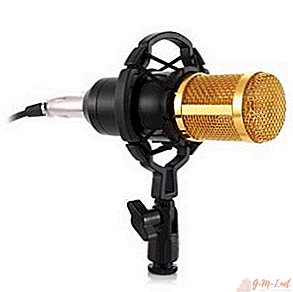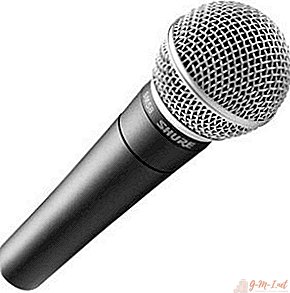There are many microphones on the market. How not to get lost in this variety and choose the one that you need? For the right choice, you should understand the principle of operation of certain parameters and take into account what indicators are required for the successful implementation of your goals.

What are the features of different types of microphones?
Consider the types of microphones:
 Condenser (electrostatic). The basis is a capacitor. One of its plates bends in the process of exposure to air vibrations; therefore, its capacity varies depending on sound pressure and frequency. The design of such models guarantees minimal sound distortion during recording. That is why precisely they are most often used when pure sound is needed - at professional recording studios. Their cost is higher than the price of models of other types. In addition, they should be carefully selected preamplifier and provide phantom power.
Condenser (electrostatic). The basis is a capacitor. One of its plates bends in the process of exposure to air vibrations; therefore, its capacity varies depending on sound pressure and frequency. The design of such models guarantees minimal sound distortion during recording. That is why precisely they are most often used when pure sound is needed - at professional recording studios. Their cost is higher than the price of models of other types. In addition, they should be carefully selected preamplifier and provide phantom power.- Electret. It is a kind of capacitor, however, does not need phantom power, because it has a built-in preamplifier. A change in the capacitance of the capacitor is also applied here, but one of its plates is made of an electret. This material may have a surface charge for a long time. The simplicity, reliability, low cost and good sensitivity of these models allows them to perfectly cope with the tasks of communicating on the Internet and record podcasts and video blogs. But it is still recommended to solve professional problems by choosing models of a capacitor or dynamic type.
 Dynamic. It is based on an electrocoil mounted on a membrane that constantly moves in a magnetic field under the influence of air vibrations. Being more resistant to loads than condenser ones, such microphones excellently record loud sound, and their lower sensitivity allows minimizing extraneous noise. These qualities and the reliability of dynamic microphones are determined by their use for enhancing voice at events in closed rooms and on open stages. But such models have a small frequency range and somewhat distort the recording, and their design features do not allow the creation of miniature size models.
Dynamic. It is based on an electrocoil mounted on a membrane that constantly moves in a magnetic field under the influence of air vibrations. Being more resistant to loads than condenser ones, such microphones excellently record loud sound, and their lower sensitivity allows minimizing extraneous noise. These qualities and the reliability of dynamic microphones are determined by their use for enhancing voice at events in closed rooms and on open stages. But such models have a small frequency range and somewhat distort the recording, and their design features do not allow the creation of miniature size models.- Tape. Being a kind of dynamic, perfectly sound detailing, but has a higher cost and requires a very careful attitude. The acoustic portion of ribbon microphones is an ultra-thin metal plate, so it can break at high pressure. But these models perfectly transmit both the sound of vocals and the sound of musical instruments. They give the recording pleasant softness, velvety and remove the high frequency shrillness.

What options are important when choosing?
Sensitivity, ultrasound, frequency range, direction of action - these are the parameters that must be taken into account when choosing a good electro-acoustic equipment. Consider the important nuances that you need to know for each characteristic.
- Sensitivity. The high sensitivity model picks up even subtle distant sounds. In quiet, soundproofed rooms, he perfectly conveys music and vocals. For this purpose, it is best to choose electret and capacitor models. But in crowded and noisy places it is better to use a microphone with a lower sensitivity. In this case, a dynamic microphone is more suitable: it will record more cleanly.
REFERENCE. High sensitivity is necessary at a distance from the microphone of the sound source. Low sensitivity is acceptable with a microphone located near an instrument or person.
- Sound pressure level. Determines the power of clear sound transmitted without overload.
IMPORTANT. There is a pattern: the higher the SPL of the equipment, the lower its sensitivity. Therefore, for a detailed powerful sound, it makes sense to choose a microphone with a built-in attenuator: increasing the SPL, it will prevent overloads.
- Frequency range. This characteristic reflects the ability of the equipment to capture the frequency of sounds.
ATTENTION. The acquisition of equipment with the widest range may not be financially justified. Consider the frequency of planned sound sources. The indices required for speech, vocals and different types of instruments are different.
- The focus of action. Models can amplify sound only on one or several sides at once. On this basis, they are divided into two groups:
- Omni-directional (circular) - with the same sensitivity transmit sound from anywhere, working at an angle of 360 degrees. They are often used at concerts, if at the same time as the vocals from the stage it is necessary to transmit the entire musical picture.
- Unidirectional - those that amplify the sound from only one side. Perfectly suitable for recording studios in cases of synchronous recording: for this, such a microphone is installed in front of each instrument.
In turn, unidirectional models are divided into types:
- kardioid (do not pick up only the sound from the back);
- eights (equally amplify sounds front and rear, cutting off only the side);
- supercardioid (eights with unequal shares);
- hypercardioid (eights with an even narrower diagram, which allows you to maximize isolate unwanted noise).

Why is it important to pay attention to the connection?
There are microphones with a universal connection, but more often they produce wireless and wired ones.When connecting equipment with a Jack connector, it is important to check the consistency of the pinouts of the microphone and amplifier connectors. Note that there is no common standard, so the connectors of different types of microphones with the same appearance can have different purpose contacts.
ATTENTION. An error in the connection can lead to equipment damage.
For USB or lightning-connectors, a similar problem is eliminated, but usually their connection is possible only for computers with specially installed drivers. Professional microphones have an XLR jack. The cable to them must be purchased separately.


 Condenser (electrostatic). The basis is a capacitor. One of its plates bends in the process of exposure to air vibrations; therefore, its capacity varies depending on sound pressure and frequency. The design of such models guarantees minimal sound distortion during recording. That is why precisely they are most often used when pure sound is needed - at professional recording studios. Their cost is higher than the price of models of other types. In addition, they should be carefully selected preamplifier and provide phantom power.
Condenser (electrostatic). The basis is a capacitor. One of its plates bends in the process of exposure to air vibrations; therefore, its capacity varies depending on sound pressure and frequency. The design of such models guarantees minimal sound distortion during recording. That is why precisely they are most often used when pure sound is needed - at professional recording studios. Their cost is higher than the price of models of other types. In addition, they should be carefully selected preamplifier and provide phantom power. Dynamic. It is based on an electrocoil mounted on a membrane that constantly moves in a magnetic field under the influence of air vibrations. Being more resistant to loads than condenser ones, such microphones excellently record loud sound, and their lower sensitivity allows minimizing extraneous noise. These qualities and the reliability of dynamic microphones are determined by their use for enhancing voice at events in closed rooms and on open stages. But such models have a small frequency range and somewhat distort the recording, and their design features do not allow the creation of miniature size models.
Dynamic. It is based on an electrocoil mounted on a membrane that constantly moves in a magnetic field under the influence of air vibrations. Being more resistant to loads than condenser ones, such microphones excellently record loud sound, and their lower sensitivity allows minimizing extraneous noise. These qualities and the reliability of dynamic microphones are determined by their use for enhancing voice at events in closed rooms and on open stages. But such models have a small frequency range and somewhat distort the recording, and their design features do not allow the creation of miniature size models.
Leave Your Comment